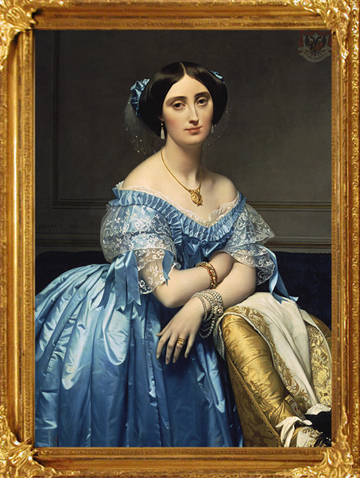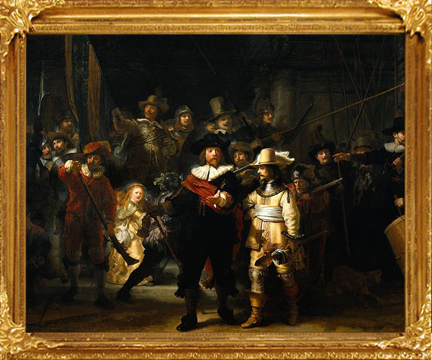The European Art
Western art is the art of Europe, and those parts of the world that have come to follow predominantly European cultural traditions such as the Americas.
Written histories of Western art often begin with the art of the Ancient Middle East, Ancient Egypt and the Ancient Aegean civilisations, dating from the 3rd millennium BC. Parallel with these significant cultures, art of one form or another existed all over Europe, wherever there were people, leaving signs such as carvings, decorated artifacts and huge standing stones. However a consistent pattern of artistic development within Europe becomes clear only with the art of Ancient Greece, adopted and transformed by Rome and carried, with the Empire, across much of Europe, North Africa and the Middle East.
The influence of the art of the Classical period waxed and waned throughout the next two thousand years, seeming to slip into a distant memory in the Medieval period, to re-emerge in the Renaissance, suffer a period of what some early art historians viewed as "decay" during the Baroque period,[1] to reappear in a refined form in Neo-Classicism and to be re-born in Post-Modernism.
The other major influence upon Western art has been Christianity, the commissions of the Church, architectural, painterly and sculptural, providing the major source of work for artists for about 1400 years, from 300 AD to about 1700 AD. The history of the Church was very much reflected in the history of art, during this period.
Secularism has influenced Western art since the Classical period, while most art of the last 200 years has been produced without reference to religion and often with no particular ideology at all. On the other hand, Western art has often been influenced by politics of one kind or another, of the state, of the patron and of the artist.
Western art is arranged into a number of stylistic periods, which, historically, overlap each other as different styles flourished in different areas. Broadly the periods are, Classical, Byzantine, Medieval, Renaissance, Baroque, Modern. Each of these is further subdivided.
The gallery of European art need to say "thank you" to French Louvre(French: Musée du Louvre). Their generous lending of "Princesse Albert de Broglie " and "Raft of the Medusa" make our exhibition more splendid.
|
 Princesse Albert de Broglie
Princesse Albert de Broglie
Princesse Albert de Broglie, née Joséphine-Eléonore-Marie-Pauline de Galard de Brassac de Béarn, 1853
Jean Auguste Dominique Ingres (pronounced [ɛ̃ːɡʁ]) (August 29, 1780 – January 14, 1867) was a French Neoclassical painter. Although he considered himself a painter of history in the tradition of Nicolas Poussin and Jacques-Louis David, by the end of his life it was Ingres' portraits, both painted and drawn, that were recognized as his greatest legacy.
A man profoundly respectful of the past, he assumed the role of a guardian of academic orthodoxy against the ascendant Romantic style represented by his nemesis Eugène Delacroix. His exemplars, he once explained, were "the great masters which flourished in that century of glorious memory when Raphael set the eternal and incontestable bounds of the sublime in art ... I am thus a conservator of good doctrine, and not an innovator." Nevertheless, modern opinion has tended to regard Ingres and the other Neoclassicists of his era as embodying the Romantic spirit of his time, while his expressive distortions of form and space make him an important precursor of modern art.
After Ingres completed his portrait of the comtesse d'Haussonville (The Frick Collection, New York) in 1845, it was suggested that he also paint one of her beautiful new sister-in-law, the twenty-eight-year-old princesse de Broglie (1825–1860). By all accounts the princess was a shy, deeply religious woman. Prior to her premature death from consumption seven years later, she raised five sons and wrote a detailed, two-volume study, Christian Virtues Explained by Examples Drawn from the Lives of the Saints, which was published posthumously by her husband.
|
 Nightwatch
Nightwatch
The painting may be more properly titled The Company of Frans Banning Cocq and Willem van Ruytenburch. It is on prominent display in the Rijksmuseum, Amsterdam, the Netherlands, and is its most famous painting.
The painting is renowned for three elements: its colossal size (363 x 437 cm ~ 11ft 10in x 14ft 4in), the effective use of light and shadow, and the perception of motion in what would have been, traditionally, a static military portrait.
This painting was completed in 1642, at the peak of the Netherlands' golden age. It depicts the eponymous company moving out, led by Captain Frans Banning Cocq (dressed in black, with a red sash) and his lieutenant, Willem van Ruytenburch. With effective use of sunlight and shade, Rembrandt leads the eye to the three most important characters among the crowd, the two gentlemen in the centre (from whom the painting gets its original title), and the small girl in the centre left background. Behind them the company's colours are carried by the ensign, Jan Visscher Cornelissen.
|
 Raft of the Medusa
Raft of the Medusa
The Raft of the Medusa (French: Le Radeau de la Méduse) is a work by the French painter Théodore Géricault, and one of the icons of French Romanticism. An extremely large painting (491 × 717 cm), it was highly controversial at its first appearance in the Salon of 1819, attracting passionate praise and condemnation. The painting depicts the desperate survivors of the French frigate Medusa, which gained notoriety when it struck the Bank of Arguin off the coast of Mauritania in 1816, at their first moment of apparent rescue.
The painting was a political statement – the incompetent captain was an inexperienced but politically sound anti-Bonapartist – and an artistic achievement that galvanized romantic painting and led to a break from the neoclassical style. The work was realized on the epic scale of a history painting, yet and for the first time in France — it was based on a current news story. The unblemished musculature of the central figure, waving to the supposed rescue ship, is reminiscent of the neoclassical, but the painting is broadly romantic. The naturalism of light and shadow, authenticity of the haggard bodies, and emotional character of the composition, differentiate it from neoclassical austerity. The Raft of the Medusa was a further departure from earlier works because it depicted contemporary events with ordinary and unheroic figures, rather than religious or classical themes. However the ragged state of the figures' clothes means that the "unromantic" nature of modern dress was an issue that could be largely bypassed.
Asian Art
Ancient Sculpture
Middle East Art

Back to the Main Page
|
 Princesse Albert de Broglie
Princesse Albert de Broglie
 Nightwatch
Nightwatch
 Raft of the Medusa
Raft of the Medusa
